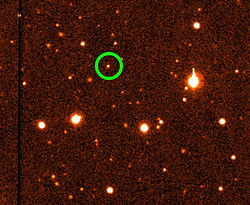Orcus
| 90482 Orcus | |
|---|---|
 Orcus med sin måne Vanth fotograferet fra Hubble-rumteleskopet i 2006 | |
| Opdaget | |
| 17. februar 2004, af M. E. Brown, C. Trujillo og D. Rabinowitz | |
| Kredsløb om Solen | |
| Afstand til Solen (massecenter) |
|
| Halve storakse | 5 859 700 000 km |
| Excentricitet | 0,22701 |
| Siderisk omløbstid | 245,19 år (89.557 dage) |
| Omløbshastighed |
|
| Banehældning | 20.592° |
| Periapsisargument; ω | 72,614 ° |
| Opstigende knudes længde; Ω | 268,6964 ° |
| Omgivelser | |
| 1 måne (Vanth) | |
| Fysiske egenskaber | |
| Diameter | 910+50−40 km;[1] 917±25 km[2] |
| Masse | (6.348±0.019)×1020[3] kg |
| Massefylde | 1.53+0.15−0.13 g/cm3[2] kg/m³ |
| Tyngdeacc. v. ovfl. | ≈ 0,2 m/s² |
| Undvigelseshastighed v. ækv. | ≈ 1 548 km/t |
| Rotationstid | 13,188 t[4] |
| Albedo | 0.231+0.018−0.011[2] % |
| Temperatur v. ovfl. | Gnsn. < 44 K[5] °C |

90482 Orcus er et trans-Neptunsk objekt i Kuiperbæltet i vores solsystem. Det har en diameter på omtrent 910 kilometer. Orcus blev opdaget i 2004 af de tre amerikanske astronomer Chad Trujillo, Mike Brown (California Institute of Technology) og David Rabinowitz (Yale University).[7]
I 2005 viste optagelser fra Hubble-rumteleskopet, at Orcus havde en tilhørende måne med en omløbstid på lidt under 10 dage. Orcus' måne blev i 2010 navngivet Vanth.[8]
Referencer
- ^ Brown, Michael E.; Butler, Bryan J. (22. januar 2018). "Medium-sized satellites of large Kuiper belt objects". The Astronomical Journal. 156 (4): 164. arXiv:1801.07221. doi:10.3847/1538-3881/aad9f2.
- ^ a b c Fornasier, S.; Lellouch, E.; Müller, P., T.; et al. (2013). "TNOs are Cool: A survey of the trans-Neptunian region. VIII. Combined Herschel PACS and SPIRE observations of 9 bright targets at 70–500 µm". Astronomy & Astrophysics. 555: A92. arXiv:1305.0449v2. Bibcode:2013A&A...555A..15F. doi:10.1051/0004-6361/201321329.
- ^ Grundy, Will M.; Noll, Keith S.; Roe, Henry G.; Buie, Marc W.; Porter, Simon B.; Parker, Alex H.; Nesvorný, David; Levison, Harold F.; Benecchi, Susan D.; Stephens, Denise C.; Trujillo, Chad A. (2019). "Mutual Orbit Orientations of Transneptunian Binaries" (PDF). Icarus. 334: 62-78. Bibcode:2019Icar..334...62G. doi:10.1016/j.icarus.2019.03.035. ISSN 0019-1035. Hentet 2019-11-13.
- ^ "JPL Small-Body Database Browser: 90482 Orcus (2004 DW)" (2020-01-04 last obs.). Jet Propulsion Laboratory. 29. januar 2020. Hentet 20. februar 2020.
- ^ Barucci, M. A.; Merlin; Guilbert; Bergh; Doressoundiram; et al. (2008). "Surface composition and temperature of the TNO Orcus". Astronomy and Astrophysics. 479 (1): L13-L16. Bibcode:2008A&A...479L..13B. doi:10.1051/0004-6361:20079079.
- ^ "Distant Planetoid". solarsystem.nasa.gov. NASA. Hentet 18. maj 2019.
- ^ 2004 DW. Astrophysics Data System, marts 2004. Hentet 4. februar 2022.
- ^ Brown, M.E., Ragozzine, D., Stansberry, J., Fraser, W.C. (2010) The size, density, and formation of the Orcus-Vanth system in the Kuiper belt. The Astronomical Journal 139: 2700–2705. doi:10.1088/0004-6256/139/6/2700.
Links
| ||||||||||||||||||
| ||||||||||||||||||||||||||||||
| Spire Denne artikel om astronomi er en spire som bør udbygges. Du er velkommen til at hjælpe Wikipedia ved at udvide den. |
Medier brugt på denne side
90482 Orcus and its satellite Vanth, imaged by the Hubble Space Telescope's ACS/HRC imager on 3 November 2006. Source images have been in public domain since 2006-11-03. Proposal ID 10801 (Michael E. Brown).
Forfatter/Opretter: Kwamikagami, Licens: CC BY-SA 4.0
heavier line weight (1.333 px) for Orcus's planetary symbol, which is common in astrology (e.g. in the default and free Astronomicon fonts used by Astrolog, the oldest and most popular shareware (free) astrology program)
90482 Orcus. The location of Orcus is shown in the green circle (top, left). Courtesy of NASA




